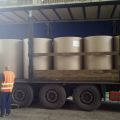BiznesOferty.pl to miejsce, w którym przedsiębiorcy zamieszczają oferty i ogłoszenia w celu nawiązywania kontaktów biznesowych. Znajdziesz tu oferty handlowe, sprzedaży, zlecenia, pomysły na własny biznes, ogłoszenia współpracy i inne. Działamy od 2003 roku.
- Biznes Oferty.pl
- / Współpraca
- / Ekologia, środowisko
- / Mączka Saponitowa
Treść oferty
Mączka Saponitowa
- Id oferty: 180715
- Info
- Dodana: 30.09.2021
- Ważna do: 04.08.2025
- Dodana: 30.09.2021
- Ważna do: 04.08.2025
- Odwiedzin: 809




- Województwo:
- mazowieckie
- Miejscowość:
- Warszawa
Szukamy partnerów do dystrybucji Saponitowej mączki (Saponit - skała mydlana)
Poszukujemy partnerów biznesowych do dystrybucji wysokiej jakości saponitowej mączki (saponit), który znajduje szerokie zastosowanie w różnych branżach, w tym rolnictwie, hodowli zwierząt, kosmetyce oraz farmacji. Oferujemy atrakcyjne warunki współpracy.
Cena: 195 EUR/tona (po odprawie celnej, na polskiej fakturze VAT) + koszty transportu z Ukrainy (region Chmielnicki).
**Zastosowanie Saponitu**:
- **W rolnictwie**: Nawóz magnezowy, poprawa jakości gleby, zabezpieczenie wilgotnych nasion, zwiększenie trwałości plonów.
- **W hodowli zwierząt**: Dodatek paszowy dla trzody chlewnej, bydła, drobiu, konserwant kiszonek.
- **W kosmetyce i farmacji**: Dodatek do mydeł, składnik kremów, suplementów diety, źródło magnezu i innych pierwiastków.
- **W ekologii**: Filtracja wody, oczyszczanie gleby, absorpcja metali ciężkich.
- **W przemyśle**: Materiał strukturotwórczy, katalizator, absorbent jonowymienny.
**Dlaczego warto współpracować?**
- **Produkt ekologiczny**: Saponit to naturalny, nietoksyczny materiał o szerokim spektrum zastosowań.
- **Dostępność**: Złoża saponitu w Ukrainie szacowane na ponad 34 miliony ton.
- **Wsparcie**: Pełne wsparcie logistyczne i formalności celne.
Zainteresowanych prosimy o kontakt.
Do treści oferty przypisane są również informacje dostępne tylko dla zalogowanych Użytkowników.
- Miejscowość:
- Warszawa
- Województwo:
- mazowieckie
- Status:
- Konto firmowe
- W BiznesOferty.pl:
- ponad 4 lata
Inne oferty dopasowane tematycznie:
Więcej ofert firmy:
- 59 zł / mieś - wirtualne biuro War...
- EBAY Niemcy - obsługa sprzedaży 7/...
- Ul. Złota - Wirtualne biuro Warsza...
- Adres dla Twojej firmy Warszawa 59...
- Sprzedawaj do Niemiec - agencja w ...
- Firma z Ukrainy nawiąże współpracę...
- Producent mebli tapicerowanych - s...
- Budowa chłodni oraz mrożni na zamó...
- Tanie karty SIM + gotówka na dowol...
- Oferta inwestycyjna nieruchomości ...
- Kredyt bankowy dla spółki zoo bez ...
- Nawiąże współpracę z pośrednikiem ...
- Żelazko w sprayu - oferta dla dyst...
- Odzież, obuwie, tekstylia (2435)
- Rolnictwo, żywność (2132)
- Chemia, oleje, paliwa (1702)
- Zdrowie, uroda (1088)
- Budownictwo (890)
- Inne ... (879)
- Medycyna, farmacja (742)
- Przemysł, automatyzacja (712)
- Meble, wyposażenie wnętrz (695)
- AGD i RTV (357)





